A Brief History of Cults and Cult-Like Websites
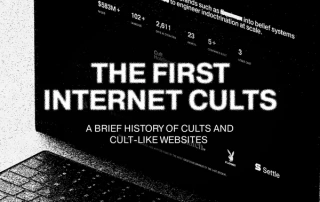
The internet didn’t begin as a tool for mass communication or commercial scale. It started in the 1960s as a military research network, an attempt to connect immobile, siloed mainframes across distance. If you wanted access to the data, you either traveled to the terminal or waited for tapes to arrive by post.
That changed on January 1, 1983, when ARPANET and the Defense Data Network officially adopted TCP/IP, the universal language of the internet. For the first time, different computers on different networks could “speak” to each other. It marked the official birth of what we now call the Internet.
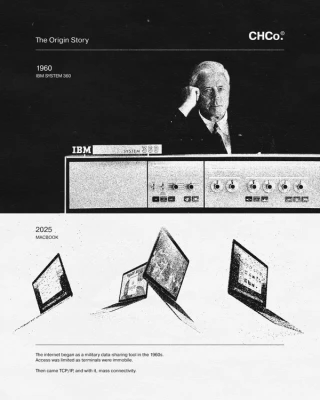
The term “cybersect” was coined by scholar Douglas E. Cowan in the early 2000s to classify belief systems that originate and operate primarily online. Introduced in Cyberhenge (2005), the concept distinguishes between traditional religions using the internet as a tool (“religion online”) and groups that form natively in digital environments (“online religion”). Cybersects use websites, forums, and digital media to recruit, distribute doctrine, and maintain control.
By 1995, less than a decade after the internet’s true genesis, two of the most infamous cults in modern history had launched fully functioning websites: Heaven’s Gate and Scientology.
Unlike 1970s cults that relied on in-person migration and counterculture momentum, such as Hare Krishna, Children of God, or the Rajneesh movement, Marshall Applewhite and L. Ron Hubbard used the internet in the mid-1990s as a tool for scale, recruitment, and control.
Early charismatic groups lost control once the media intervened; Applewhite and Hubbard reversed that dynamic. By 1995, they had launched curated websites: Heaven’s Gate as a digital “tombstone” for cosmic escape and Scientology.org as a polished recruitment interface, designed to shape interpretation. Applewhite funded his operations in part through an internal web development group called Higher Source, which offered design services to early internet clients while quietly maintaining the Heaven’s Gate website. Scientology responded to online criticism with aggressive takedown campaigns and search engine flooding, treating digital visibility as territory to control.
Both understood that in the digital age, controlling the medium means owning the myth, and they moved first to do it.
In 1994, internet usage was growing at 2,300% per year. The web was no longer purely an academic tool. The launch of Mosaic (1993) and Netscape Navigator (1994) made it accessible to everyday people.
In 1995, Amazon quietly launched. Jeff Bezos, just like Marshall Applewhite and L. Ron Hubbard, saw the internet as a tool for global control, narrative dominance, and infrastructure bypass.

Below is a short archive of early cult and cult-adjacent digital experiences that still linger online (or in memory).
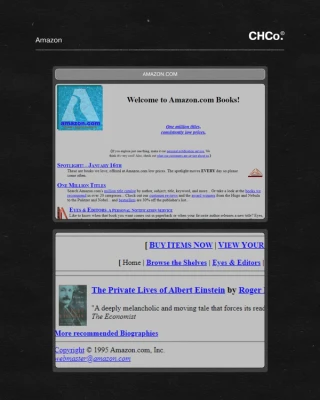
Amazon.com (1995)
[ www.Amazon.com ]
Amazon launched in July 1995 as an online bookstore, entering a market with no clear infrastructure for digital retail. Within 30 days, it was fulfilling orders across 45 countries. What began as a commerce experiment quickly evolved into a data-extraction engine, using purchase behavior, search queries, and reviews to build one of the most sophisticated consumer profiling systems in existence. By the early 2000s, Amazon introduced personalized recommendations, third-party sellers, and one-click checkout, conditioning users to expect speed and ease. Today, it operates as infrastructure, shaping how goods move, how choices are made, and how habits form at scale.
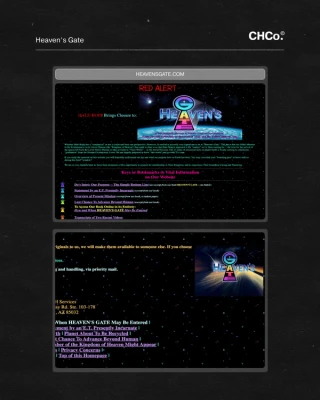
Heavensgate.com (1995)
Developed by cult members operating under the name Higher Source, this site was designed as both a doctrinal archive and a recruitment mechanism. It outlined Marshall Applewhite’s cosmology, offered pathways for new members, and detailed the group's plan for departure. At the time, it circulated quietly within UFO and fringe spiritual communities, receiving little mainstream attention. That changed in March 1997, when 39 members died by suicide in a coordinated event linked to the Hale–Bopp comet. The site became a subject of intense media scrutiny and academic interest. It remains live today, unchanged since the 1990s, maintained by two surviving members. As one of the earliest examples of a digitally native belief system, it now functions as an artifact of early internet-era religion.
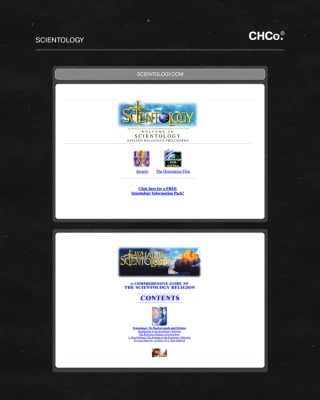
Scientology.org (1996)
[ https://www.scientology.org/ ]
Scientology.org launched in 1995 as a centralized digital asset to control public perception, recruit new members, and suppress criticism. The Church deployed aggressive SEO tactics, flooding search results with internal content to bury dissenting voices. In 2002, it filed DMCA claims to remove critical sites like Xenu.net from Google search. Internal tools like Scieno Sitter blocked members from accessing unauthorized information. Coordinated disinformation campaigns, such as forgery, disrupted online forums, leading to public backlash and the rise of Project Chanology in 2008. Today, the site remains a tightly managed gateway into the organization’s ecosystem, designed to convert, contain, and control narrative visibility.
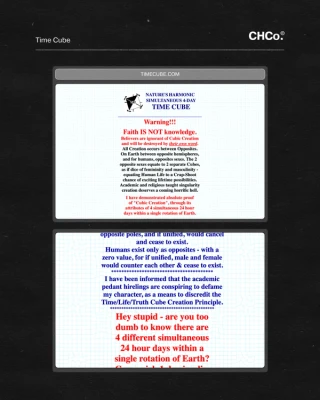
TimeCube.com (1997)
[ www.timecube.com ]
Created by Gene Ray, TimeCube was a personal cosmology built on the claim that four simultaneous days occur in a single Earth rotation. The site was a dense, all-caps screed mixing numerology, anti-establishment rhetoric, and pseudoscience, published in raw HTML with no clear navigation. It gained notoriety in early web forums and academia as a case study in internet-era delusion, even featured in lectures at MIT and Georgia Tech as an example of outsider logic and early digital extremism. Though Ray called himself the "wisest man on Earth," the site functioned more like a digital reliquary of obsession. It is now preserved via the Wayback Machine, serving as an artifact of pre-social media influencers and one of the internet’s earliest viral belief systems.
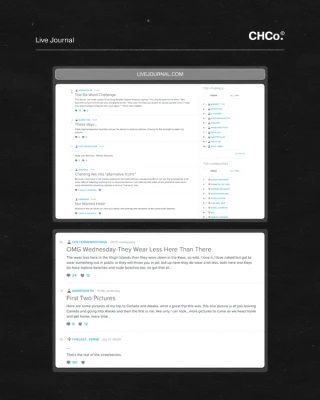
LiveJournal.com (1999 / 2000)
LiveJournal launched in 1999 and peaked in 2007 with over 12 million users and 170 million monthly pageviews. By 2024, it still hosted over 15 million monthly active users, primarily aged 25–34, with a 54 percent male user base. While not home to formal cults, LiveJournal was repeatedly linked to extremist and violent content. In 2007, a Russian nationalist group used the platform to circulate a beheading video of Shamil Odamanov, prompting international media attention and government intervention. That same year, Virginia Tech shooter Seung-Hui Cho’s LiveJournal account surfaced with posts referencing guns and isolation, later cited in investigations into his psychological profile. Communities on LiveJournal enabled early parasocial dynamics, emotional dependency, and unmoderated ideological echo chambers, conditions that, while not organized as cults, mirrored their social mechanics.

SecondLife.com (2003)
Second Life launched in 2003 and by 2007 had over 15 million registered users and a peak concurrency of 88,000, supporting a user-generated economy with over $64 million in GDP. While no verified cults or murders originated from the platform, it enabled the formation of highly organized virtual communities that replicated cultic structures, including the Gorean subculture, modeled on the "Chronicles of Gor" novels, which imposed master-slave hierarchies, rituals, and strict behavioral codes. In 2009, a U.K. woman was incarcerated for arson after her husband divorced her in-game and partnered with another user, illustrating the emotional intensity these environments could produce. Second Life also faced controversy over virtual child exploitation, prompting content crackdowns by Linden Lab. Today, with over 600,000 active monthly users, it remains one of the longest-running digital platforms for identity experimentation and belief-world construction, often studied in media psychology and virtual sociology as a prototype for immersive social architectures.
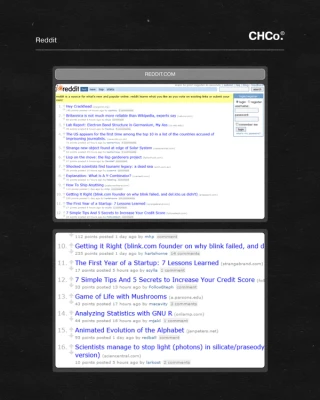
Reddit.com (2005)
Reddit, launched in 2005, has repeatedly served as an incubation space for cult-like digital communities. By 2018, it hosted over 1.2 million active subreddits, including r/GreatAwakening and r/Qult_Headquarters, which helped spread QAnon ideology before being banned. Reddit removed over 2,000 QAnon-related communities between 2019 and 2020 for violations related to harassment and misinformation. Other subreddits such as r/FemaleDatingStrategy and r/NoFap evolved into closed belief systems with behavioral codes and ideological policing, drawing academic comparisons to decentralized cult structures. A 2022 study analyzing 2.1 million Reddit comments found that explanatory narrative formats significantly increased engagement in QAnon threads, reinforcing belief loops. As of 2023, Reddit reported over 70 million daily users, 500 million monthly visitors, and annual revenue exceeding $800 million. Its structure, anonymous participation, karma-based validation, and subreddit silos continue to support high-intensity ideological enclaves that mimic cult formation at scale.
If Web1 broadcast belief and Web2 monetized identity, Web3 is reengineering belonging. Membership is the new conversion. Cult logic is back.
Our site goes live today. Our personality quiz is available for free for our first 108 users. Embrace first-mover advantage. Cult yourself.
Written + researched by ☠︎︎ ⋆₊ ♱ Alyssa Bonanno ☠︎︎ ⋆₊ ♱, cult leader of Cult Holdings Co
Primary Websites and Archives
Academic and Conceptual Sources
Media Coverage and Secondary Sources